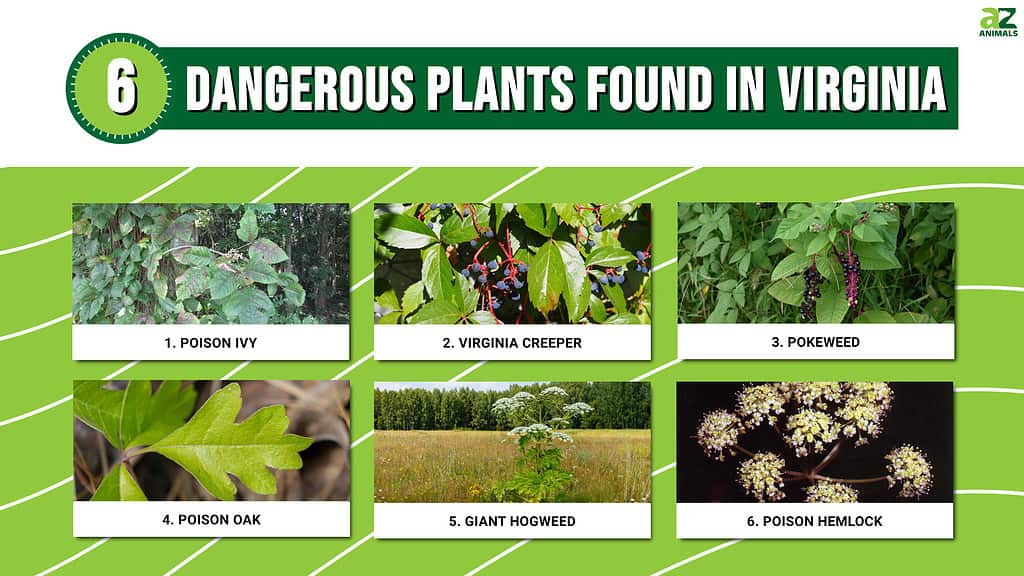
Virginia is a beautiful state with a lot of fauna and flora to enjoy. There are well over 3,000 plant species growing in the state. Not all though are friendly! Here we have 6 dangerous plants found in Virginia you should never touch or consume.
1. Poison Ivy
Poison ivy is one of the most well-known poisonous plants in the world. They grow just about anywhere, including all over Virginia. Interestingly, these three-leaf plants also grow alongside Virginia Creepers, another poisonous plant with similar symptoms. To avoid a reaction from touching poison ivy, you should know what this plant looks like.
Poison ivy can grow as a shrub, small plant, or climbing vine. In the wild, it frequently grows on trees and the side of older buildings. Poison ivies have clusters of three leaflets. This is why many people warn you not to touch anything with leaves of three. The leaves are smooth and egg-shaped but sometimes contain toothed margins. During the flowering season, poison ivies grow light green flowers which produce white berries.
So, what happens if you touch this uncomfortable allergenic plant? Not everyone has the same reaction. Some people break out into hives and blisters within just a few minutes of rubbing a leaf. The effects of poison ivy aren’t rare either. About 350,000 people in the United States alone are affected by poison ivy. The rash can get worse if you continue touching the plant. You can also spread it by touching objects like phones or door handles. Although uncomfortable, there are many remedies. If you suspect you are having an allergic reaction to poison ivy, wash the affected area immediately to get rid of the sap irritating. While rare, some reactions may require hospitalization.
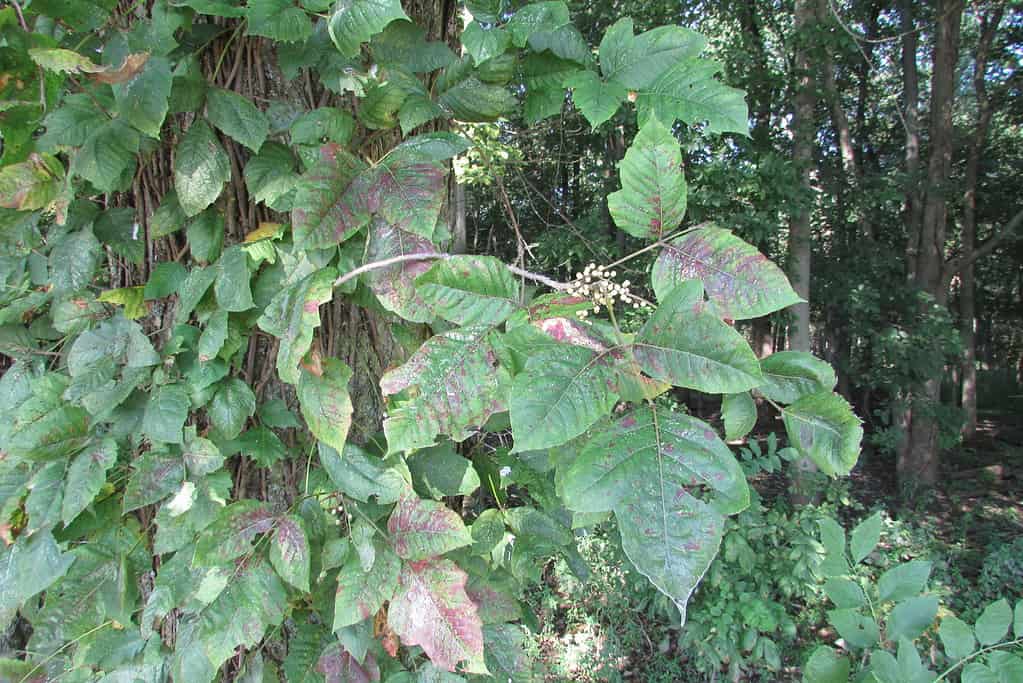
Poison ivy can cause an allergic reaction including rashes and blisters.
©Chris Light / CC BY-SA 4.0 – License
2. Virginia Creeper
Another common dangerous plant in Virginia is the Virginia creeper. As you may have guessed, this name comes from Virginia as this plant is found throughout the state. Other names for this plant include Victoria creeper, five-finger, woodbine, and five-leaved ivy. The Virginia Creeper belongs to the grape family, Vitaceae.
This plant is an excellent climber and grows quickly, sometimes reaching up to 100 feet long in the wild. This plant climbs using small tendrils with sticky pads. Virginia creepers vary slightly in appearance. Some have 3, 5, or 7 leaflets, although 5 are more common. So, what makes this plant so dangerous?
Virginia creepers produce a sap within the leaves and stem that has a high concentration of raphides. These raphides can cut through the skin and cause rashes and allergic reactions. While the effects are minimal, you should avoid picking Virginia creeper leaves. The plant is also dangerous for dogs if accidentally consumed.
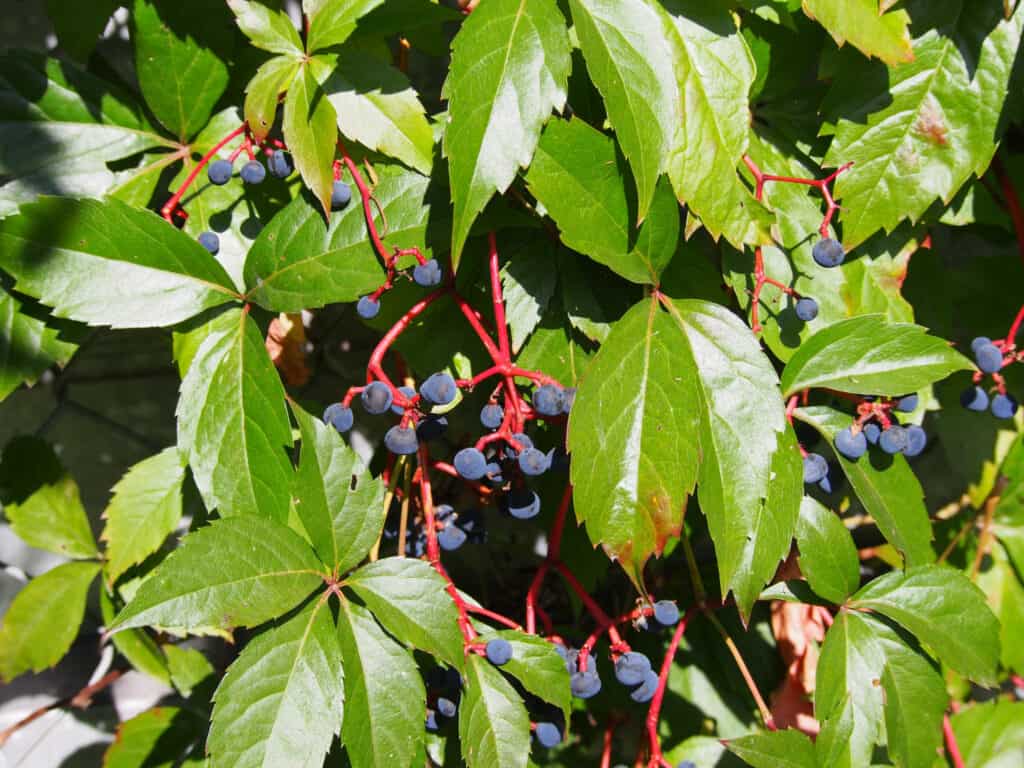
The Virginia Creeper is a dangerous plant in Virginia that can cause skin irritation and blisters.
©Anna Gratys/Shutterstock.com
3. Pokeweed
There are many dangerous plants found in Virginia, and the next one on our list is pokeweed. This plant has many names like American pokeweed, inkberry, and dragon berries. It’s very poisonous and should not be consumed! This plant is native to parts of North America but has been introduced to Europe and Asia. Pokeweed is very dangerous for livestock and is regarded as a pest by farmers since the plant grows and spreads quickly.
Pokeweed in one year of growing can shoot up to 8 feet tall! Some pokeweed plants though only reach 4 feet. The plant’s leaves are light green with purple or red stems. The green and white flowers bloom in spring, eventually producing purple (almost black) berries. While this plant is beautiful, it’s also very dangerous!
All parts of the plant are dangerous. However, the highest concentration of toxins is in the roots, leaves, and ripened fruit. Even unripened green berries though are toxic. If you consume this plant in small quantities, the effects can go away in 1 to 2 days. However, you may need hospitalization. Within a few hours of consumption, some people are left with bloody diarrhea and dehydrating vomiting. Children are most vulnerable to pokeweed poisoning as they are attracted to the bright berries.
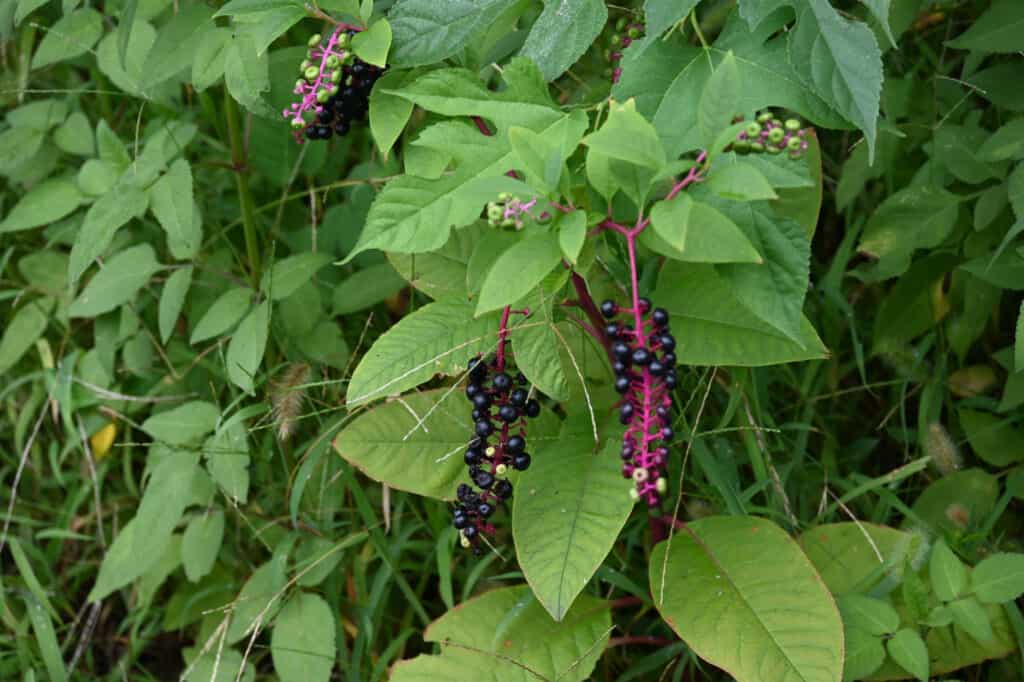
Pokeweed is very dangerous and consuming any part of the plant can lead to hospitalization.
©tamu1500/Shutterstock.com
4. Poison Oak
Poison oak resembles poison ivy and also leaves people with similar reactions. This plant is also known as Atlantic poison oak. It’s a poisonous shrub or small tree that can grow up to 3 feet tall. This allergenic plant is part of the Anacardiaceae family. It is very abundant in Virginia but can be found as far west as Oklahoma and Texas. This plant is easy to avoid if you know what to look for. It usually grows in thick woods and forests. The leaves have three leaflets and are hairy. The leaves look very similar to white oak leaves.
So, what makes this plant dangerous? Poison oaks contain, urushiol, an allergenic mixture that has similar effects as poison ivy. If you’ve come in contact with this plant, the effects begin with a light red and mild rash that can worsen and blister. Not everyone though has an allergic reaction to the urushiol.
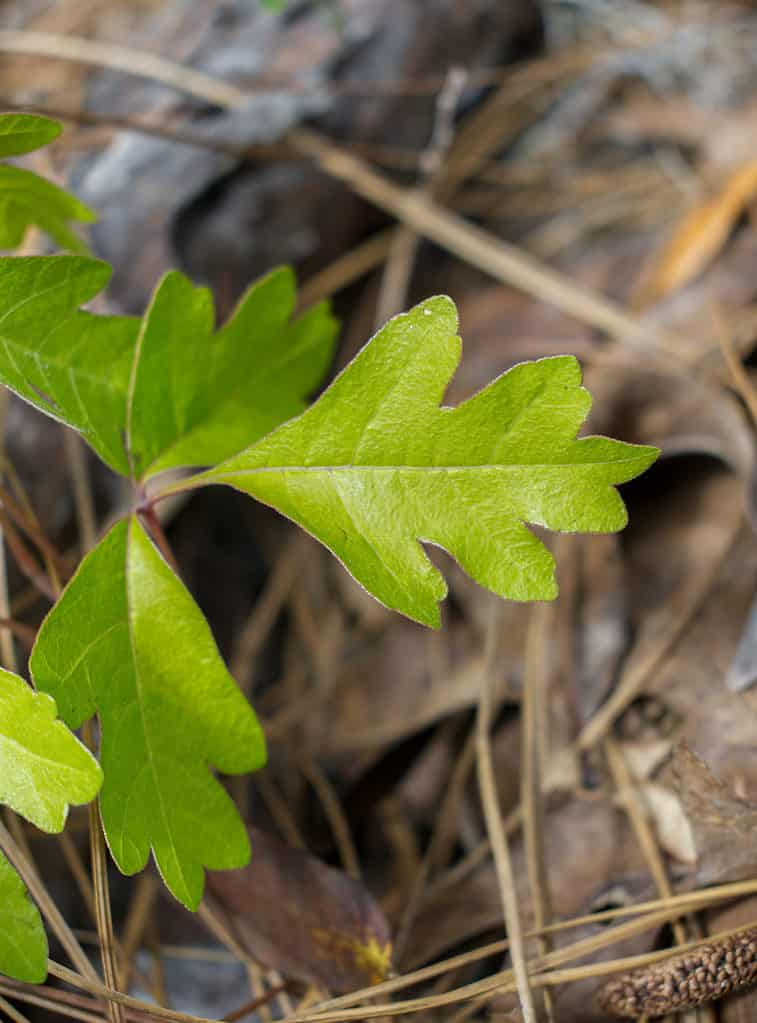
Poison oak is very similar to poison ivy.
©iStock.com/Dan Rieck
5. Giant Hogweed
Have you ever heard of giant hogweed? This plant is large and invasive. It’s native to the western Caucasus region of Eurasia but is found across North America, including parts of Canada and the United States. This plant first began spreading in the 19th century when it was brought to England as a beautiful ornamental plant. Giant hogweed, as its name suggests, is a very large plant! It can easily reach impressive lengths up to 18 feet. This plant is especially known for producing tiny white clusters of flowers in summer.
Like other poisonous plants on this list, the sap is toxic. It contains a chemical that leads to phytophotodermatitis. If you touch this plant and get the sap on your skin, this means your skin won’t be able to protect itself against the sun. The reaction is quick and can happen in as little as 15 minutes. The reaction can also last for a few days.
Giant hogweed spreads quickly and is listed as a federal noxious weed by the U.S. government. It first came to North America in the 20th century to be placed in Victorian gardens. In the western United States though, it’s unknown as to how the plant spread. This dangerous plant found in Virginia grows in open fields and roadsides.
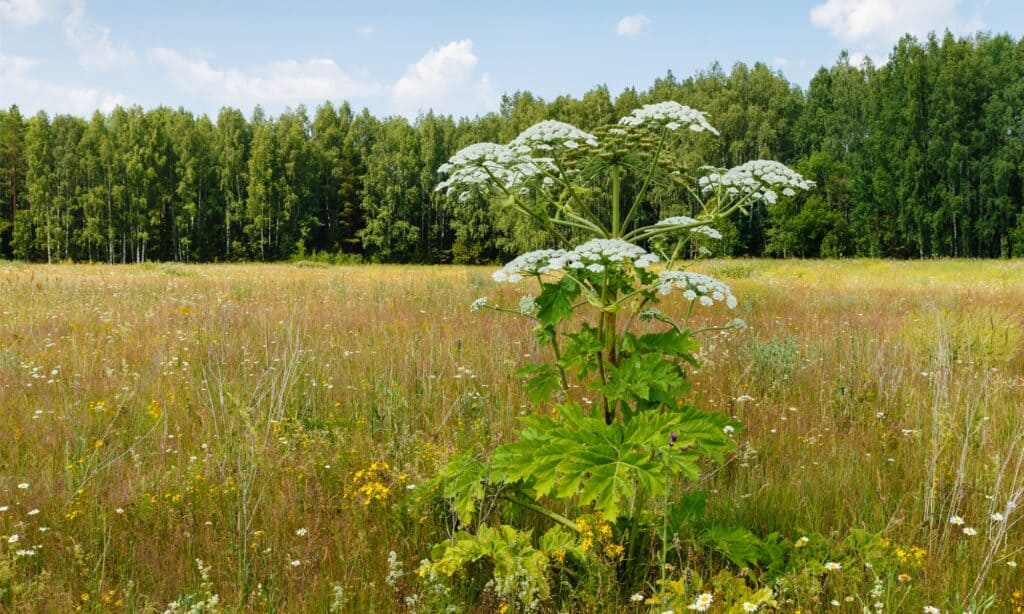
Giant hogweed is an invasive plant found throughout the United States.
©iStock.com/Mieszko9
6. Poison Hemlock
Another dangerous plant found in Virginia is the poison hemlock. This plant, like the giant hogweed, is invasive in the United States. It’s native to Europe and North Africa and is a member of the carrot family. This plant has been widely naturalized and introduced. It spreads quickly and grows in many environments because of its hardiness.
Poison hemlock is a flowering plant that can reach between 5 to 8 feet tall. However, occasionally, it can grow up to 12 feet. This plant has beautiful and smooth green stems with streaks of purple or red. The leaves are thin and lacy. This plant doesn’t produce flowers until its second year. The flowers are tiny, white, and grow in clusters.
Poison hemlock should not be consumed or touched. However, the effects are worse if you consume the toxic plant. All parts of the plant contain some level of toxins. This plant can poison humans, but it’s more common in cattle and other livestock. Poison hemlock is a big problem in the spring for farmers as it grows quickly and is more poisonous during spring. The flowers and seeds are bitter and most animals leave the plant alone. Common symptoms of hemlock poisoning include vomiting, fever, trembling, and rapid respiration.

The western water hemlock is the most poisonous plant on the North American continent.
©Robert H. Mohlenbrock / Public Domain – License
Summary of 6 Dangerous Plants Found in Virginia
| Rank | Dangerous Plant |
|---|---|
| 1 | Poison Ivy |
| 2 | Virginia Creeper |
| 3 | Pokeweed |
| 4 | Poison Oak |
| 5 | Giant Hogweed |
| 6 | Poison Hemlock |
The photo featured at the top of this post is © BestStockFoto/Shutterstock.com
Thank you for reading! Have some feedback for us? Contact the AZ Animals editorial team.






